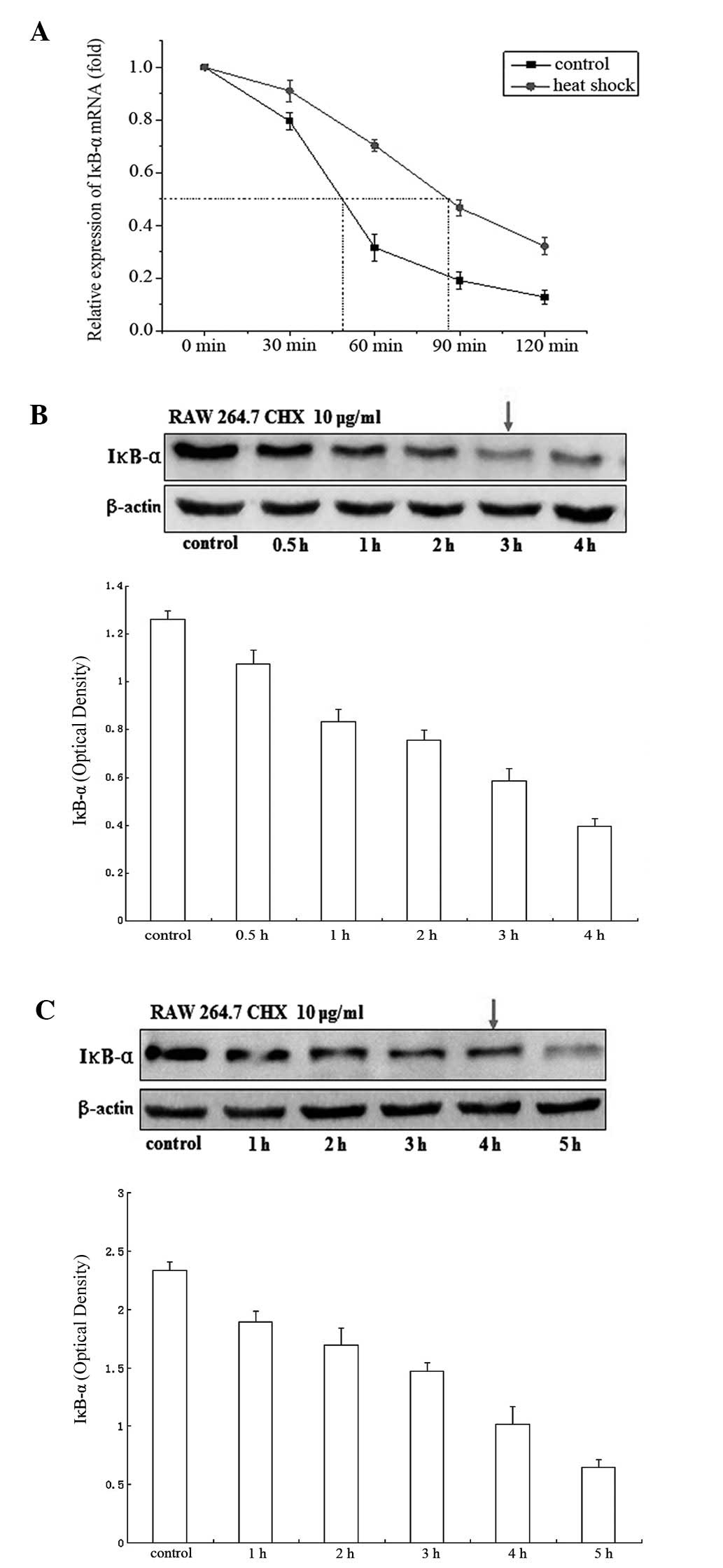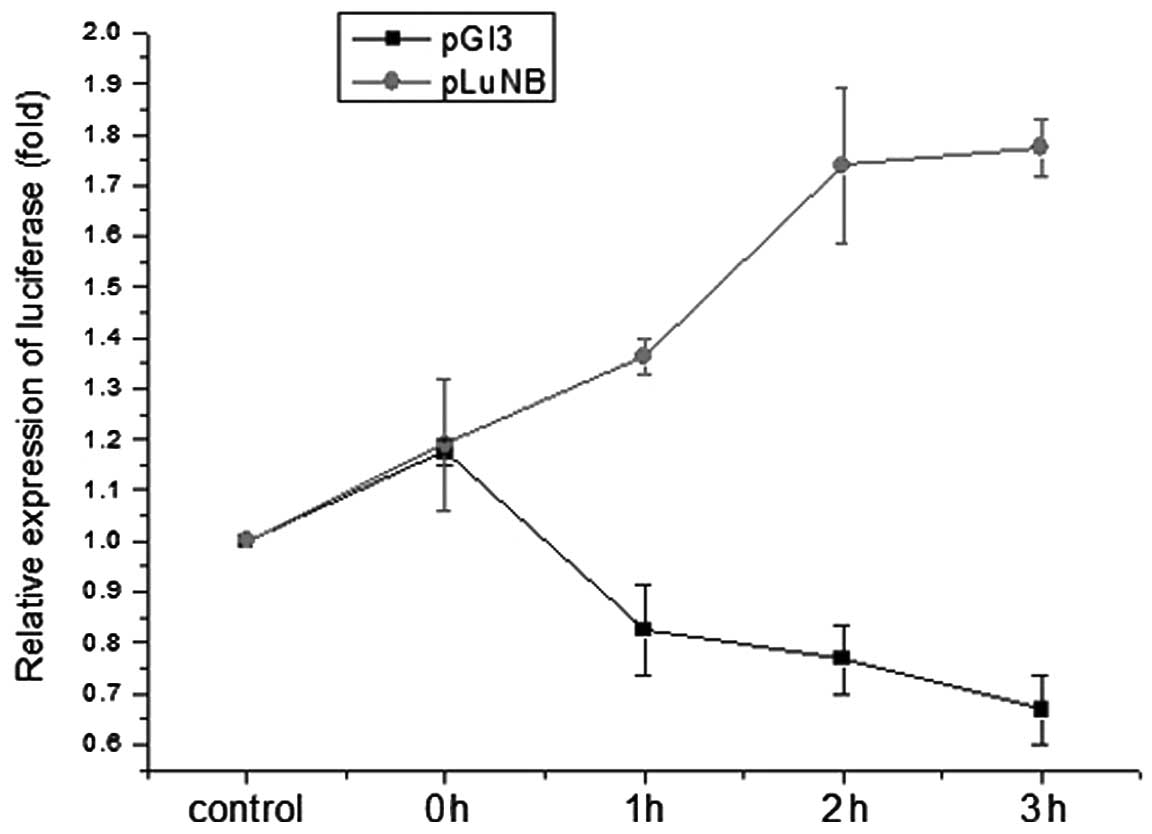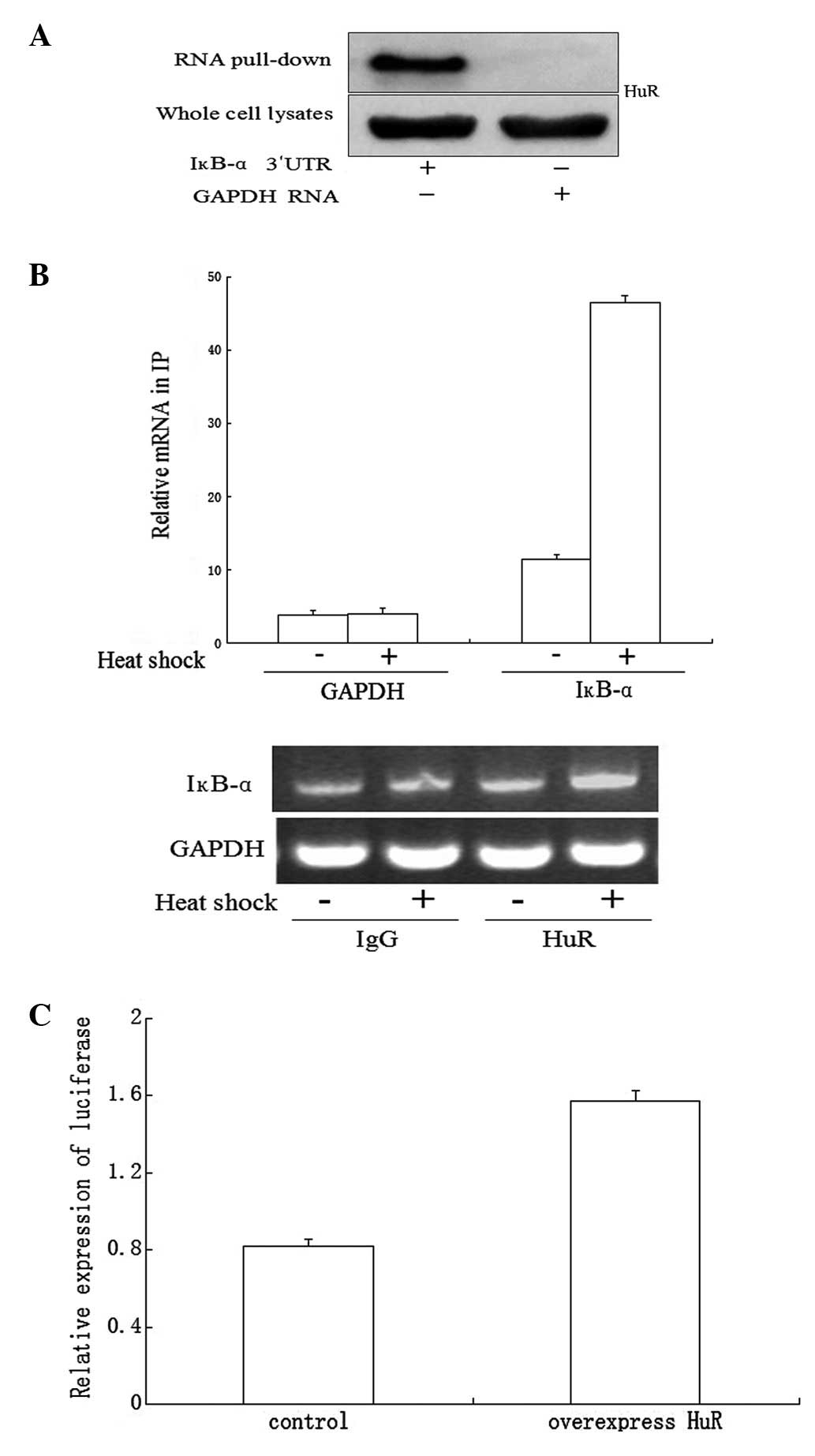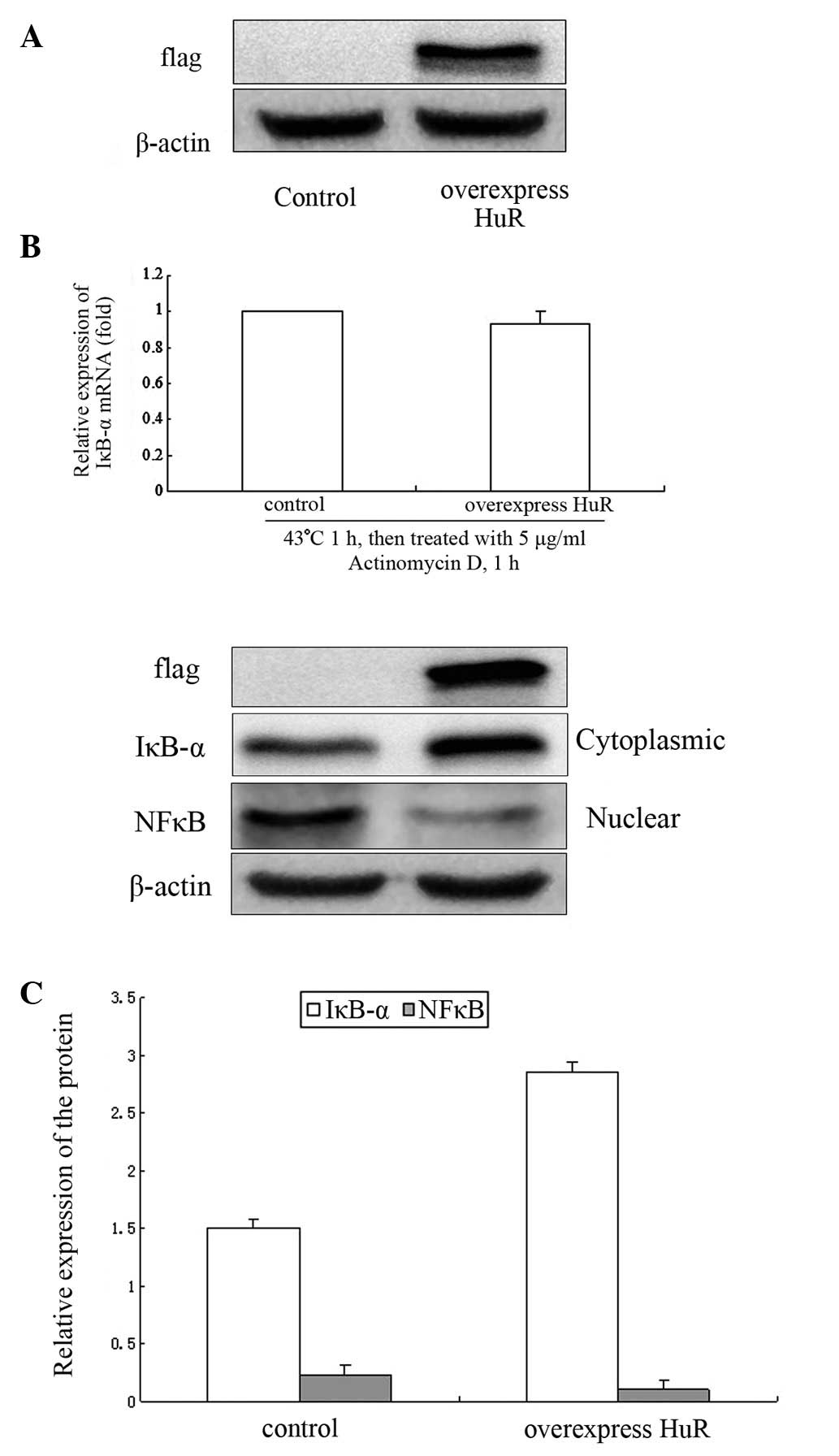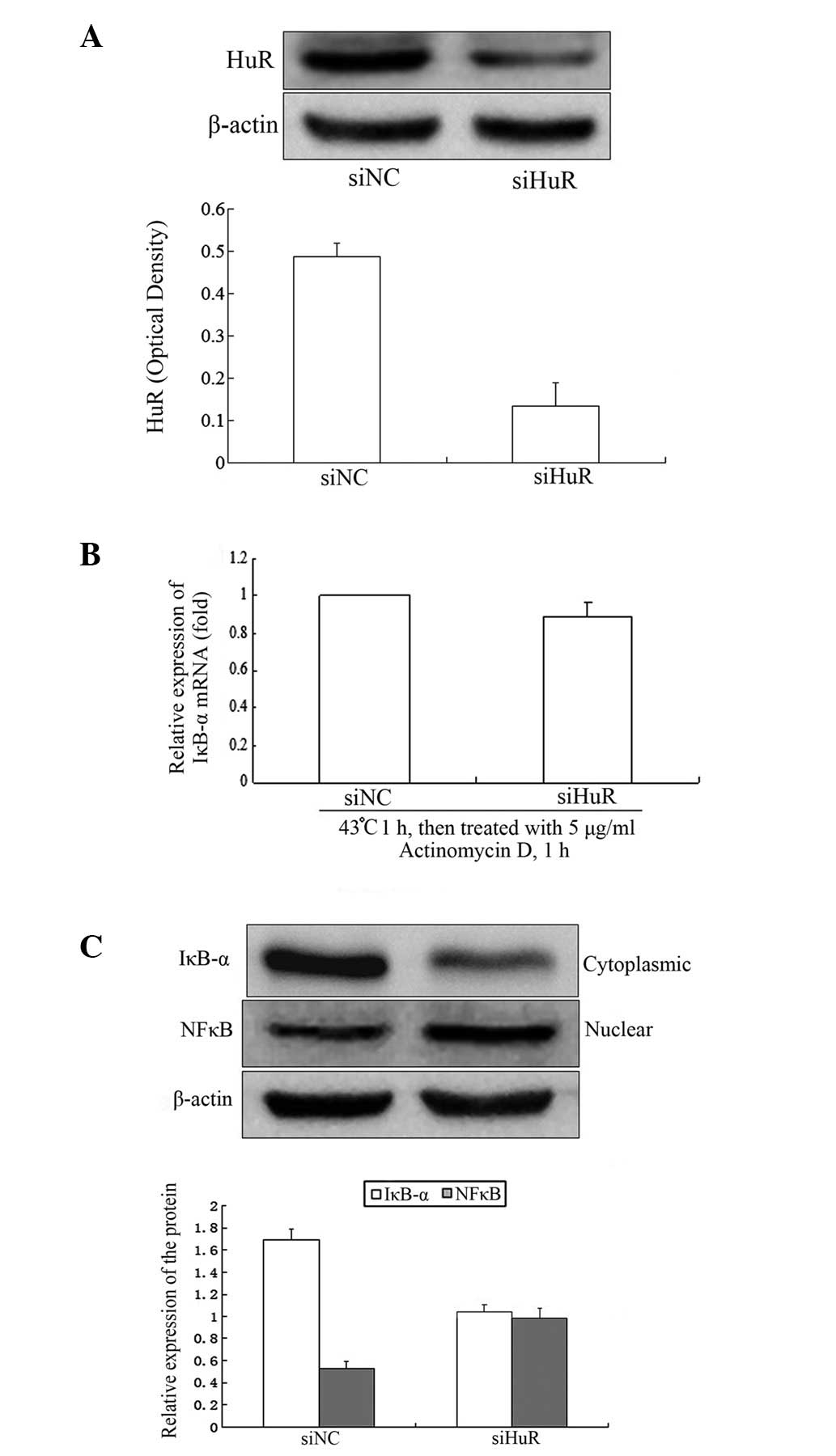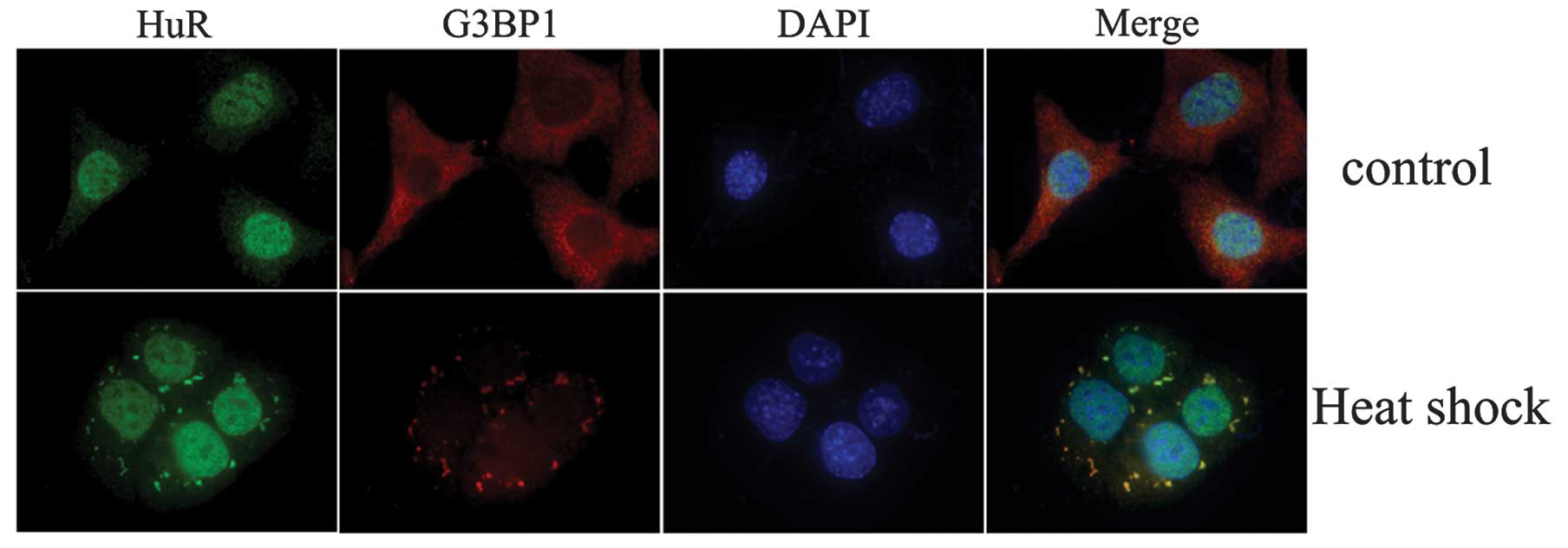Heat shock‑mediated regulation of IκB‑α at the post‑transcriptional level by HuR
- Authors:
- Published online on: November 20, 2013 https://doi.org/10.3892/mmr.2013.1820
- Pages: 553-559
Abstract
Introduction
Heat shock treatment protects against a variety of cell and tissue injuries, including sepsis, acute lung injury, ischemia reperfusion injury and endotoxin-mediated apoptosis (1). One of the mechanisms by which heat shock treatment induces tolerance is via the inhibition of key signaling pathways, including nuclear factor κB (NF-κB), which transcriptionally regulate stress-response genes. Heat shock treatment has been demonstrated to inhibit activation of the NF-κB pathway by mechanisms involving inhibition of the inhibitor of NF-κB (IκB) kinase activation (2–4). Heat shock has also been demonstrated to increase the mRNA stability of a number of genes (5,6).
NF-κB is a critical transcription factor involved in a broad range of biological processes, including immune responses, cell survival, stress responses and maturation of various cell types. NF-κB activation is required to protect organisms from environmental factors, however, deregulated NF-κB activity has been observed in various diseases, including chronic inflammation and cancer. Thus, understanding the regulation of NF-κB signaling is important for maintaining human health.
The IκB proteins are important for the regulation of NF-κB signaling. The classical inhibitor proteins in the NF-κB signaling system consist of the single polypeptide IκBs, IκB-α, IκB-β and IκB-ɛ. In resting cells, IκB binds and sequesters the NF-κB dimer and prevents DNA binding and transcriptional activation. Stimulus-responsive activation of the IκB kinase results in the degradation of the IκBs to release and activate NF-κB (4).
From these observations, the mechanism by which heat shock treatment modulates NF-κB signaling cascades was investigated, in particular the Iκ-Bα gene expression with a focus on post-transcriptional regulation.
Materials and methods
Cell culture and heat shock
NIH 3T3 and RAW264.7 murine macrophages (American Type Culture Collection, Manassas, VA, USA) were cultured in DMEM (Gibco-BRL, Carlsbad, CA, USA) supplemented with 10% fetal bovine serum (Gibco-BRL) in a 95% room air-5% CO2 incubator at 37°C. Heat shock treatment was performed by incubating cells at 43°C for 1 h in a 95% room air-5% CO2 incubator with subsequent return to 37°C.
Plasmid construction
Mouse (flag)-tagged HuR and the pRL-TK plasmid were used. Full-length HuR mRNA 3′UTR was amplified using specific primers and cloned into the pcDNA3-flag vector (Promega, Madison, WI, USA) using the KpnI and XbaI sites. The following primers were used: sense, 5′-GTGGTACCA TGTCTAATGGTTATGAAGACCAC-3′ and anti-sense, 5′-GCTCTAGAGCTGTCTGTAAAAATCT GTTTAAT-3′. Full-length IκB-α mRNA 3′UTR was amplified using specific primers and cloned into the pGL3 vector (Promega) using the XbaI and NcoI sites and named pLuNB. The following primers were used: sense, 5′-ATCGCCGTGTAATGGAAAGTGGCAAAAAG AATG-3′ and anti-sense, 5′-GCTCTAGAGCTGTCTGTAAA AATCTGTTTAAT-3′.
Transient transfection
pLuNB and control plasmids were transfected using Lipofectamine 2000™ (Invitrogen Life Technologies, Carlsbad, CA, USA). Transfected cells were used for analysis 48 h following transfection.
Luciferase assays
Cells were transfected and cultured in six-well plates at a density of 3×105 cells/well. Following 1 h heat shock, cells were washed with PBS once and cellular proteins were extracted and analyzed for luciferase activity according to the manufacturer’s instructions (Promega GmbH) with the use of a luminometer (SpectarMax M5, Molecular Devices, Sunnyvale, CA, USA). Luciferase activity was corrected for total cellular protein and reported as relative induction over respective control cells (cells that were transfected with pGL3 control plasmid).
RNA interference
A mixture of small interfering RNAs (siRNAs; 25 nM; GenePharma, Shanghai, China) specifically targeting HuR was transfected into cells using Lipofectamine 2000. The following sets of primers were used: Elavl1-mus-360 sense, 5′-GCGAGGUUGAAUCUGCAAATT-3′ and antisense, 5′-UUUGCAGAUUCAACCUCGCTT-3′; Elavl1-mus-1099 sense, 5′-GACCAUGACAAACUAUGAATT-3′ and antisense, 5′-UUCAUAGUUUGUCAUGGUCTT-3′; Elavl1-mus-522 sense, 5′-CAAGCUCAGAGGUCAUCAATT-3′ and antisense 5′-UUGAUGACCUCUGAGCUUGTT-3′.
RNP immunoprecipitation (IP) assays
For the IP assay of endogenous RNA-protein complexes from whole-cell extracts, cell lysates were incubated with protein A-Sepharose beads (Sigma-Aldrich, St. Louis, MO, USA) that had been precoated with 30 μg mouse immunoglobulin G1 (IgG1; BD Biosciences San Jose, CA, USA) or antibodies recognizing HuR (Santa Cruz Biotechnology, Inc., Santa Cruz, CA, USA) for 3 h at 4°C. Beads were washed with NT2 buffer [50 mM Tris-HCl (pH 7.4), 150 mM NaCl2, 1 mM MgCl2 and 0.05% Nonidet P-40], incubated with 20 units RNase-free DNase I (15 min; 30°C) and further incubated in 100 μl NT2 buffer containing 0.1% SDS and 0.5 mg/ml proteinase K (30 min; 55°C).
RNA isolated from the IP material was reverse transcribed using random hexamers and SSII reverse transcriptase (Invitrogen Life Technologies). Transcription abundance was measured by amplification of cDNA, using quantitative PCR (qPCR) employing SYBR-Green PCR master mix (Applied Biosystems China, Beijing, China). PCR primers for the detection of IκB-α and β-actin were as follows: IκB-α sense, 5′-GAAGAGAAGCCGCTGACCAT-3′ and antisense, 5′-CAGAAGTGCCTCAGCAATTCC-3′; β-actin sense, 5′-ACGGCCAGGTCATCACTATTG-3′ and antisense, 5′-AGAGGTCTTTACGGATGTCAACGT-3′.
Biotin pull-down analysis
For in vitro synthesis of biotinylated transcripts, cDNA from RAW264.7 cells was used as a template for PCR, whereby the T7 RNA polymerase promoter sequence [CCAAGCTTCTAATACGACTCACTATAGGGAGA(T7)] was added to the 5′ end of all fragments. The primers used for the preparation of biotinylated transcripts spanning the 3′UTR of IκB-α (GenBank accession, no. NM_004417) and GAPDH were as follows: primers (T7), 5′-ATCGCCGTGTAATGGAAAGTGGCAAAAAGAATG-3′ and 5′-GCTCTAGAGCTGTCTGTAAAAATCTGTTT AAT-3′, were used for preparing the IκB-α 3′UTR and primers (T7), 5′-CAGCAAGAGCACAAGAGGAA-3′ and 5′-AGGGGTCTACATGGCAACTG-3′ were used to prepare the GAPDH transcripts. Biotinylated RNAs were synthesized using a MaxiScript T7 kit (Ambion, Carlsbad, CA, USA). Whole-cell lysates were incubated with 2 μg purified biotinylated transcripts for 1 h at room temperature. Complexes were isolated with paramagnetic streptavidin-conjugated Dynabeads (Dynal®, Invitrogen, Carlsbad, CA, USA) and bound proteins in the pulldown material were assayed by western blotting using antibodies against HuR (Santa Cruz Biotechnology Inc.).
mRNA stability assays
Cells were subjected to heat shock treatment for 1 h. Following heat shock, the cells were treated with actinomycin D (5 μg/ml; Sigma-Aldrich) to induce transcriptional arrest. Total RNA was harvested at 0.5 h intervals. Control cells were maintained at 37°C, treated with actinomycin D and harvested for total RNA isolation at 0.5 h intervals. Total RNA samples were subjected to qPCR as previously described (3).
Nuclear protein extraction
Nuclear extraction procedures were performed on ice. Cells were washed twice with PBS, harvested in 1 ml PBS and pelleted at 3,300 × g for 5 min. The pellet was washed twice with PBS, resuspended in one packed cell volume of lysis buffer [10 mM HEPES, (pH 7.9), 10 mM KCl, 0.1 mM EDTA, 1.5 mM MgCl2, 0.2% v/v Nonidet P-40, 1 mM DTT and 0.1 mM PMSF] and incubated for 5 min. Following centrifugation at 6,000 rpm, one cell pellet volume extraction buffer [20 mM HEPES, (pH 7.9), 420 mM NaCl, 0.1 M EDTA, 1.5 mM MgCl2, 25% v/v glycerol, 1 mM DTT and 0.5 mM PMSF] was added to the nuclear pellet and incubated on ice for 15 min with occasional vortexing. Nuclear proteins were isolated by centrifugation at 14,000 rpm for 15 min. Protein concentrations were determined by the Bradford assay (Bio-Rad, Hercules, CA, USA) and stored at −80°C for western blot analysis.
Protein stability assays
CHX (10 μg/ml; Sigma-Aldrich) was added to the culture medium 1 h following heat shock treatment and at the indicated time points (0.5, 1, 2, 3 and 4 h), cells were collected and protein stability was analyzed by immunoblotting.
Western blot analysis
Cells were harvested and washed twice with PBS. Harvested cells were lysed and 80 μg total protein was separated by SDS-PAGE on 10% polyacrylamide gels and transferred onto nitrocellulose membranes. Following 1 h blocking with 5% skimmed milk in TBS buffer (10 mM Tris and 150 mM NaCl), membranes were incubated with primary antibodies at 4°C overnight. Membranes were washed four times for 15 min with TBST buffer (10 mM Tris, 150 mM NaCl and 0.1% Tween 20) and incubated with the appropriate HRP-conjugated secondary antibody for 1 h at room temperature. Protein bands were detected using an enhanced chemiluminescene western blotting detection kit (Amersham, Buckinghamshire, UK). All antibodies were purchased from Santa Cruz Biotechnology.
Immunofluorescence
Cells were washed with ice-cold PBS and fixed for 10 min using 4% formaldehyde in PBS. The cells were permeabilized using 0.1% Triton X-100 in PBS for 5 min, washed with ice-cold PBS and blocked with 5% bovine serum albumin in PBS for 1 h at 37°C. Subsequently, cell preparations were incubated with anti-HuR or anti-G3BP1 antibodies diluted in 5% bovine serum albumin at 4°C (Santa Cruz Biotechnology) and underwent additional washes with ice-cold PBS, cells were incubated with a secondary antibody (Santa Cruz Biotechnology), washed with PBS and incubated with a solution of DAPI for 10 min. Following preparation, cells were washed thoroughly and were embedded using ProLong Gold antifade reagent (Invitrogen Life Technologies). Images were captured using a fluorescence microscope (Zeiss Axiovert 35).
Statistical analysis
Data were presented as mean ± SD of three independent assays. The statistical analysis was conducted by one-way ANOVA. P<0.05 was considered to indicate a statistically significant difference.
Results
Heat shock increases IκB-α mRNA and protein stability
To explore the effect of heat shock on IκB-α, RAW264.7 murine macrophages were subjected to heat shock treatment. RNA and protein were extracted and examined for IκB-α mRNA and protein stability by qPCR and western blotting, respectively. The results showed that the IκB-α mRNA had a half-life of ~48 min in untreated cells and this increased to ~80 min following heat shock treatment (Fig. 1A). IκB-α protein had a half-life of ~3 h (Fig. 1B) which increased to ~4 h (Fig. 1C) following heat shock treatment. The results indicate that treatment with heat shock potently stabilizes IκB-α mRNA and proteins.
3′UTR IκB-α mRNA is important for regulating the function of IκB-α upon heat shock treatment
3′-UTR mRNA may regulate the mRNA stability and translation efficiency, thus, the mechanism by which the 3′UTR of IκB-α mRNA regulates the function of IκB-α upon heat shock treatment was investigated. RAW264.7 cells were transiently transfected with a 3′UTR IκB-α luciferase reporter plasmid and luciferase activity was measured in cells subjected to heat shock treatment. Exposure to heat shock significantly increased luciferase activity in transfected cells compared with cells transfected with the control plasmid (Fig. 2). These observations demonstrate that the 3′UTR of IκB-α mRNA exerts an important role in regulating the function of IκB-α upon heat shock treatment.
HuR binds to endogenous and recombinant IκB-α mRNA
The IκB-α mRNA has a long AU-rich 3′UTR containing a number of predicted hits of a previously identified HuR motif. Thus, we determined whether IκB-α mRNA is the target of HuR in mRNA stabilization and/or translation and if such RNA protein associations changed in a heat shock-dependent manner. First, the existence of such RNA binding protein was analyzed by employing a biotin pull-down assay. Following the pull-down assay using streptavidin-coated beads, western blotting analysis revealed that HuR associates specifically with IκB-α 3′UTR transcripts but not with GAPDH 3′UTR transcripts (Fig. 3A).
RNP IP analysis was then performed to investigate the association of endogenous HuR with endogenous mRNAs. Using lysates from untreated RAW264.7 cells, RNP IP assays revealed an ~11-fold enrichment in IκB-α mRNA associated with HuR in anti-HuR antibody IP reactions compared with the control IgG IP reactions. Using lysates from heat shock-treated cells, the association of MKP-1 mRNA with HuR was >45-fold higher than that observed in control cells (Fig. 3B). As a negative control, the abundance of housekeeping GAPDH mRNA in HuR IP samples was comparable with that observed following IgG IP and remained unchanged by heat shock treatment (Fig. 3B). The relative enrichment of these mRNAs in each RNP IP reaction was also investigated by qPCR, followed by conventional PCR amplification and visualization on agarose gels (Fig. 3B).
HuR affects the function of the IκB-α mRNA 3′UTR
To determine the role of HuR in heat shock-mediated regulation of the IκB-α mRNA 3′UTR, NIH 3T3 cells were transiently cotransfected with the 3′UTR of IκB-α luciferase reporter plasmid and flag-HuR plasmid as described and luciferase activity was measured following heat shock treatment. Overexpression of HuR increased luciferase activity compared with the control group cotransfected with luciferase reporter control plasmid and flag-HuR plasmid (Fig. 3C).
Effect of overexpression of HuR on IκB-α mRNA stability and protein expression
To explore the effect of HuR on the regulation of IκB-α at the post-transcriptional level, NIH 3T3 cells were transfected with flag-HuR plasmid for 48 h and IκB-α mRNA stability was detected by qPCR and IκB-α and NF-κB protein by western blotting. The flag-HuR plasmid was expressed at high levels in NIH 3T3 cells (Fig. 4A). There was little change in IκB-α mRNA stability following heat shock treatment (Fig. 4B). Overexpression of HuR may increase the expression of IκB-α protein. IκB-α protein increased by ~50% compared with the control group. NF-κB protein levels in the nucleus were decreased by ~55% (Fig. 4C).
Effect of HuR on IκB-α mRNA stability and protein expression
NIH 3T3 cells were transfected with siRNA specifically targeting HuR for 48 h. The results revealed that HuR protein decreased by ~75% (Fig. 5A). There was little effect on IκB-α mRNA stability following heat shock treatment (Fig. 5B). IκB-α protein levels decreased by ~40% compared with the control group and the nuclear NF-κB protein levels increased by ~50% (Fig. 5C).
Subcellular distribution changes of HuR
To investigate whether HuR undergoes nucleus-to-cytoplasmic shuttling upon heat shock treatment, NIH 3T3 cells were treated by heat shock for 1 h. It was observed that HuR was primarily localized in the nucleus and G3BP1 was primarily localized in the cytoplasm of resting cells, whereas relocalization of HuR from the nucleus to the cytoplasm was observed following 1 h of heat shock treatment. HuR was observed to colocalize with G3BP1 protein to form stress granules (SGs; Fig. 6).
Discussion
It has been established that preconditioning with heat shock treatment confers protection against inflammation-associated tissue and organ injury (7,8). Accordingly, the mechanisms by which heat shock modulates inflammation-associated signal transduction were investigated, particularly in cells of the monocyte/macrophage line. The present study focused on the IκB/NF-κB pathway, clearly demonstrating that heat shock inhibits NF-κB activation in vitro and in vivo, in agreement with Malhotra and Wong (9). The mechanisms which govern this modulation have been of particular interest.
Activation of the NF-κB pathway results in the expression of inflammatory and immune response genes. These signals must be transient and well regulated as prolonged NF-κB activation may lead to abnormal gene expression and the deregulation of NF-κB activation has been involved in various pathologies, including chronic inflammation and cancer. The biological importance of the IκBs as negative feedback regulators in NF-κB signaling has been established. The expression of IκB-α and IκB-ɛ may be induced and function as negative feedback regulators of NF-κB. IκB-α knockouts cause mortality 7–10 days following birth due to hyperinflammation (10). In addition, mice with mutated κB enhancers of the IκB-α promoter exhibit a shortened life span (13–15 months), hypersensitivity to septic shock and abnormal T-cell development/activation (11). Negative feedback limits the duration of stimulus-induced NF-κB activity and the magnitude of the gene expression response, but may also mediate the transduction of stimulus-specific information via a ‘temporal signaling code’ that determines which of the many possible target genes are activated in response to a specific stimulus. IκB-α deficiency results in inappropriate gene expression (12). The distinct degradation pathways between the free and bound IκBs result in highly dynamic homeostatic control of the NF-κB signaling module, which imparts functional robustness to this signaling system.
Eukaryotes employ multiple post-transcriptional mechanisms to adjust their gene expression programs in response to external cues and changes in the physiological status of the cell (13,14). A major role in post-transcriptional hierarchy is played by RNA-binding proteins (RBPs) that regulate virtually every aspect of mRNA metabolism, from nuclear processing reactions and export to the cytoplasm to translation and stability (15,16). HuR is one of the most popular RBPs. HuR associates with mRNAs bearing U/AU-rich sequences, typically present in 3′UTRs (17). The IκB-α mRNA possesses a long, AU-rich 3′UTR, containing predicted binding sites of an HuR motif, thus, the RNA binding protein HuR was selected as a target. RNA pull-down and RNP IP was employed to investigate the association between HuR and IκB-α mRNA. HuR was observed to be associated specifically with IκB-α 3′UTR transcripts upon heat shock treatment and RNP IP assays revealed a 45-fold enrichment in IκB-α mRNA associates with HuR in anti-HuR antibody IP reactions relative to that of control IgG IP reactions. These observations indicate that HuR associates prominently with IκB-α mRNA following heat shock treatment. In addition, the effect of HuR on the regulation of IκB-α at the post-transcriptional level was investigated. The results showed that overexpression of HuR increases the expression of IκB-α protein which, in turn, decreases NF-κB in the nucleus. Knockdown of HuR decreased IκB-α protein levels, increasing NF-κB in the nucleus, but had little effect on the stability of IκB-α mRNA.
Although HuR is located predominantly in the nucleus, its post-transcriptional effect is linked to its translocation to the cytoplasm, where it stabilizes and/or modulates the translation of numerous target mRNAs. Changes in the subcellular distribution of HuR upon heat shock treatment was observed. The results indicate that HuR is primarily located in the nucleus without heat shock treatment and translocates to the cytoplasm with heat shock where HuR and G3BP1 protein colocalize. G3BP1 proteins are the main content of the SG (18). SGs typically contain stalled mRNAs, 40S ribosomal subunits and a number of translational initiation factors, including eIF2 and eIF3 and RNA binding proteins.
In the present study, HuR was demonstrated to translocate between the nucleus and the cytoplasm, binding to the IκB-α mRNA upon heat shock treatment. HuR was observed to modulate the translation of IκB-α mRNA without affecting the half-lives. The exact mechanism by which HuR modulates the translation of IκB-α mRNA and the effect on the NF-κB pathway remain to be elucidated.
Acknowledgements
Financial support was provided by grants from the National Science Foundation of China (no. 81171476), Natural Science Funds for Distinguished Youth Team of Zhejiang Province (no. R2101166), the Scientific Innovation Team Project of Ningbo, China (no. 2011B82014) China and the Scientific Project of Ningbo, China (no. XKL11D2116). Sponsored by K.C. Wong Magna Fund of Ningbo University, Ningbo, China.
References
|
Shanley TP, Ryan MA, Eaves-Pyles T and Wong HR: Heat shock inhibits phosphorylation of IkappaBalpha. Shock. 14:447–450. 2000. View Article : Google Scholar : PubMed/NCBI | |
|
Grossman BJ, Shanley TP, Odoms K, Dunsmore KE, Denenberg AG and Wong HR: Temporal and mechanistic effects of heat shock on LPS-mediated degradation of IkappaBalpha in macrophages. Inflammation. 26:129–137. 2002. View Article : Google Scholar : PubMed/NCBI | |
|
Kohn G, Wong HR, Bshesh K, Zhao B, Vasi N, Denenberg A, Morris C, Stark J and Shanley TP: Heat shock inhibits tnf-induced ICAM-1 expression in human endothelial cells via Ikappakinase inhibition. Shock. 17:91–97. 2002. View Article : Google Scholar : PubMed/NCBI | |
|
Pittet JF, Lee H, Pespeni M, O’Mahony A, Roux J and Welch WJ: Stress-induced inhibition of the NF-kappaB signaling pathway results from the insolubilization of the IkappaB kinase complex following its dissociation from heat shock protein 90. J Immunol. 174:384–394. 2005. View Article : Google Scholar : PubMed/NCBI | |
|
Deng L, Wang C, Spencer E, Yang L, Braun A, Slaughter C, Pickart C and Chen ZJ: Activation of the IkappaB kinase complex by TRAF6 requires a dimeric ubiquitin conjugating enzyme complex and a unique polyubiquitin chain. Cell. 103:351–361. 2000. View Article : Google Scholar : PubMed/NCBI | |
|
Ouaaz F, Arron J, Zheng Y, Choi Y and Beg AA: Dendritic cell development and survival require distinct NF-kappaB subunits. Immunity. 16:257–270. 2002. View Article : Google Scholar | |
|
Wong HR: Potential protective role of the heat shock response in sepsis. New Horiz. 6:194–200. 1998.PubMed/NCBI | |
|
Wong HR and Wispé JR: The stress response and the lung. Am J Physiol Lung. 273:L1–L9. 1997.PubMed/NCBI | |
|
Malhotra V and Wong HR: Interactions between the heat shock response and the nuclear factor-kappaB signaling pathway. Crit Care Med. 30(1 Supp): S89–S95. 2002. View Article : Google Scholar | |
|
Beg AA, Sha WC, Bronson RT and Baltimore D: Constitutive NF-kappaB activation, enhanced granulopoiesis and neonatal lethality in IkappaBalpha-deficient mice. Genes Dev. 9:2736–2746. 1995. View Article : Google Scholar : PubMed/NCBI | |
|
Peng B, Ling J, Lee AJ, Wang Z, Chang Z, Jin W, Kang Y, Zhang R, Shim D, Wang H, Fleming JB, Zheng H, Sun SC and Chiao PJ: Defective feedback regulation of NF-kappaB underlies Sjogren’s syndrome in mice with mutated kappaB enhancers of the IkappaBalpha promoter. Proc Natl Acad USA. 107:15193–15198. 2010.PubMed/NCBI | |
|
Hoffmann A, Levchenko A, Scott ML and Baltimore D: The IkappaB-NF-kappaB signaling module: temporal control and selective gene activation. Science. 298:1241–1245. 2002. View Article : Google Scholar | |
|
Moore MJ: From birth to death: the complex lives of eukaryotic mRNAs. Science. 309:1514–1518. 2005. View Article : Google Scholar : PubMed/NCBI | |
|
Moore MJ and Proudfoot NJ: Pre-mRNA processing reaches back to transcription and ahead to translation. Cell. 136:688–700. 2009. View Article : Google Scholar : PubMed/NCBI | |
|
Glisovic T, Bachorik JL, Yong J and Dreyfuss G: RNA-binding proteins and post-transcriptional gene regulation. FEBS Lett. 582:1977–1986. 2008. View Article : Google Scholar : PubMed/NCBI | |
|
Sanchez-Diaz P and Penalva LO: Post-transcription meets post-genomic: the saga of RNA binding proteins in a new era. RNA Biol. 3:101–109. 2006. View Article : Google Scholar : PubMed/NCBI | |
|
López de Silanes I, Zhan M, Lal A, Yang X and Gorospe M: Identification of a target RNA motif for RNA-binding protein HuR. Proc Natl Acad USA. 101:2987–2992. 2004.PubMed/NCBI | |
|
Anderson P and Kedersha N: Stressful initiations. Cell. 115:3227–3234. 2002.PubMed/NCBI |



